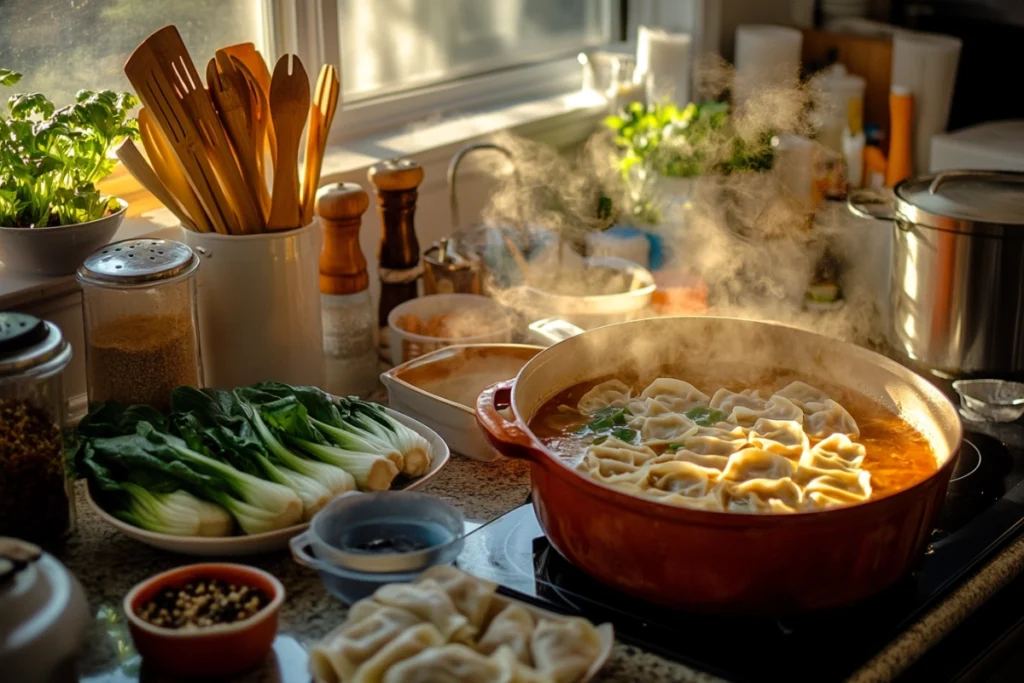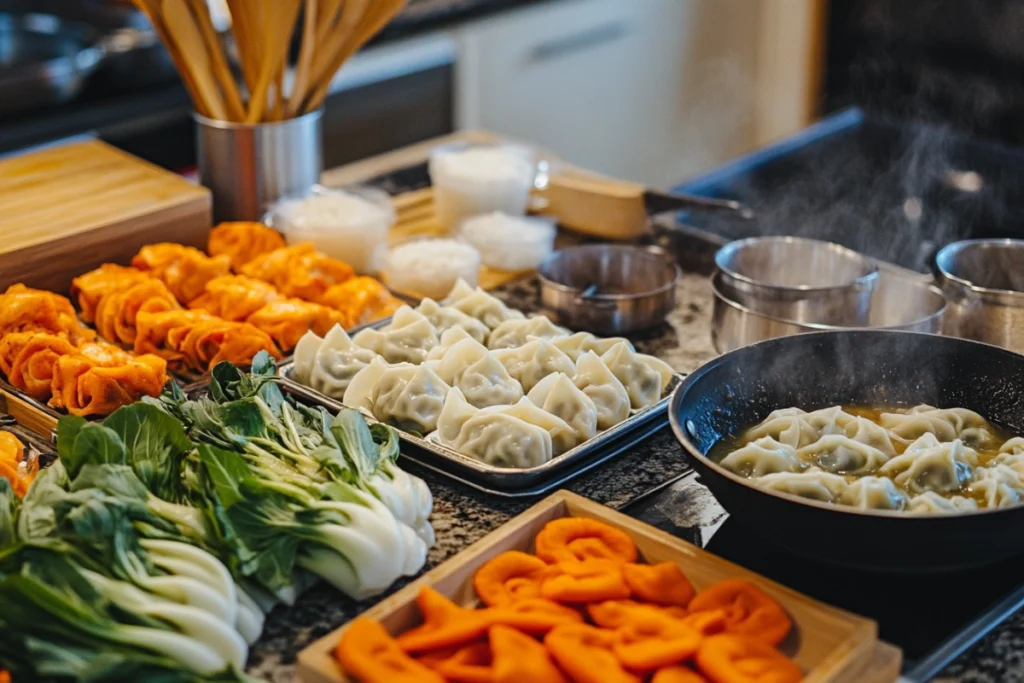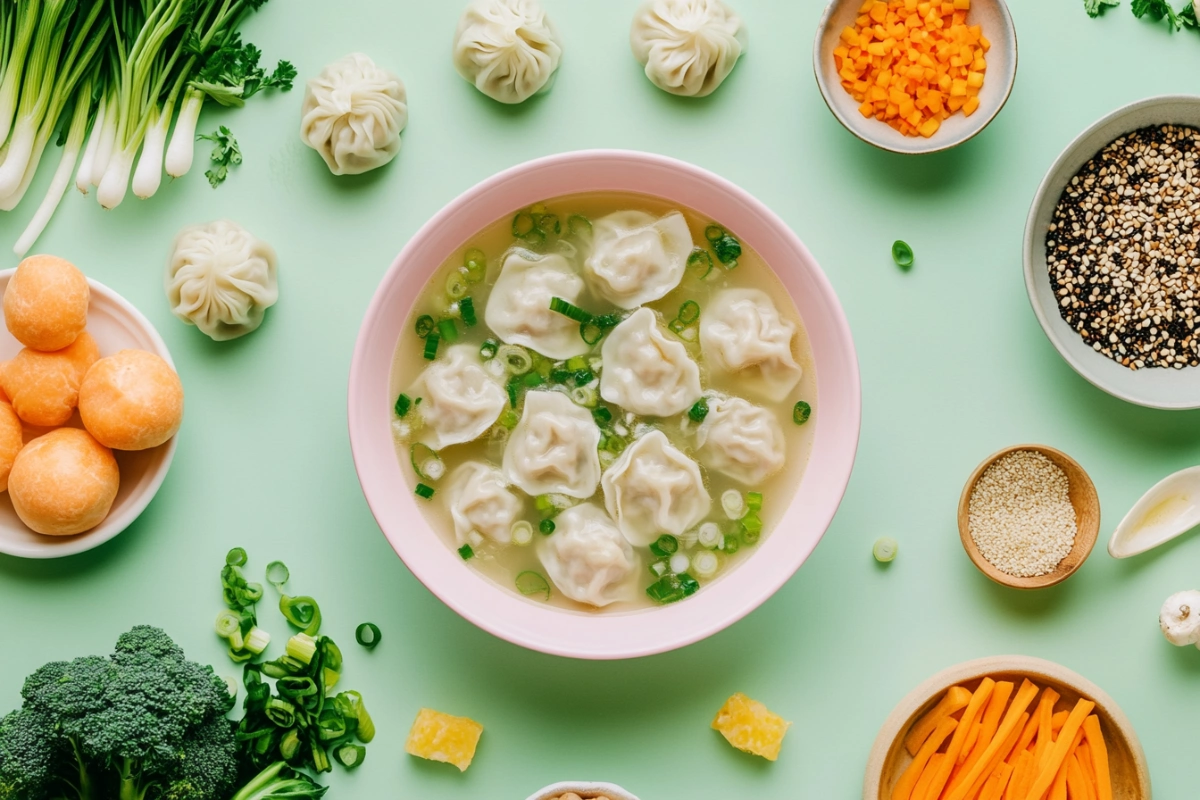When it comes to comfort food with an international flair, wonton soup often tops the list. This popular dish from Chinese cuisine is a delightful combination of tender dumplings, aromatic broth, and an assortment of flavors that can satisfy any palate. But if you’re watching your health or trying to make informed dietary choices, you might be asking, “Is wonton soup from Chinese restaurants healthy?” This article dives deep into the nutritional profile, health considerations, and ways to enjoy wonton soup guilt-free. Let’s get started.
What Is Wonton Soup?
The History of Wonton Soup
Wonton soup is steeped in tradition, originating in ancient China as a humble yet satisfying dish. The word “wonton” translates to “swallowing clouds,” which perfectly describes the appearance of these delicate dumplings floating in a light, savory broth. Traditionally, wontons were considered a symbol of togetherness and shared during special occasions like Lunar New Year.
Today, wonton soup is a beloved staple at Chinese restaurants worldwide, catering to a variety of tastes with regional twists. From chicken-filled wontons in Hong Kong to seafood-infused versions in coastal regions, this dish’s versatility is part of its charm.
Key Ingredients in Traditional Wonton Soup
At its core, traditional wonton soup features a few simple yet flavorful components:
- Wontons: These dumplings are typically filled with a mixture of ground chicken, shrimp, and seasonings like ginger, garlic, and soy sauce. The filling is encased in a thin wrapper made from wheat flour and water.
- Broth: A light, clear broth made from chicken, beef bones, or a combination of both serves as the base. It’s often seasoned with soy sauce, sesame oil, and a hint of white pepper.
- Vegetables and Garnishes: Many versions include bok choy, scallions, or cilantro for added freshness and texture.
Although these ingredients may seem simple, their combination creates a complex and satisfying flavor profile. However, the healthiness of the dish depends largely on preparation methods and portion sizes—topics we’ll explore in the sections ahead.
Nutritional Profile of Wonton Soup
Why Nutrition Matters
Understanding the nutritional content of wonton soup can help answer the question, “Is wonton soup from Chinese restaurants healthy?” Whether you’re monitoring calories, tracking protein intake, or watching sodium levels, knowing these details is crucial.
Below is a breakdown of the typical nutritional values of wonton soup (per 100g). These values may vary slightly depending on the recipe or preparation method, especially when dining out or using homemade versions.

Nutritional Content of Wonton Soup (Per 100g)
| Nutrient | Amount (Per 100g) | % Daily Value* |
|---|---|---|
| Calories | 70 kcal | 4% |
| Protein | 4 g | 8% |
| Total Fat | 2 g | 3% |
| Saturated Fat | 0.5 g | 2% |
| Cholesterol | 15 mg | 5% |
| Carbohydrates | 8 g | 3% |
| Fiber | 0.5 g | 2% |
| Sodium | 500 mg | 22% |
| Potassium | 90 mg | 3% |
| Vitamin A | 80 IU | 2% |
| Vitamin C | 1.5 mg | 2% |
| Calcium | 15 mg | 1% |
| Iron | 0.5 mg | 3% |
Calories and Macronutrients in Wonton Soup
Wonton soup’s calorie count can vary widely based on preparation. A typical restaurant serving provides about 200–400 calories per bowl, depending on portion size. It’s primarily composed of protein, carbohydrates, and a modest amount of fat. The wontons themselves, filled with chicken or shrimp, supply protein and fat, while the thin wrappers and broth contribute carbohydrates.
Though light in calories compared to other Chinese dishes, the exact macronutrient breakdown hinges on specific ingredients and preparation methods. For instance, using leaner meats and avoiding heavy oils can significantly reduce fat content, making it more heart-friendly.
Micronutrients and Health Benefits
The soup boasts a range of micronutrients. Shrimp-filled wontons are rich in selenium, zinc, and B vitamins, while chicken provides iron and phosphorus. The broth, often simmered with bones, adds calcium and collagen. Vegetables like bok choy or scallions contribute vitamins A and C..
However, the high sodium content in restaurant-style wonton soup is worth noting. One bowl can contain 800–1,000 mg of sodium, which is about half the recommended daily intake for most adults. To make this dish healthier, consider enjoying it in moderation or opting for low-sodium versions.
Is Wonton Soup a Healthy Choice?
Comparing Homemade vs. Restaurant Wonton Soup
Restaurant wonton soup often prioritizes taste over health. Chefs may use high-sodium broths, MSG, and less-than-lean meats to create a rich flavor profile. Homemade versions, however, provide greater control over ingredients, enabling you to cut back on sodium and fat while boosting nutritional content.
For instance, replacing beef with ground chicken or turkey, or using whole-grain wonton wrappers, can make a significant difference. Swapping traditional broths for unsalted or homemade stock further enhances the healthiness of the dish.
Factors Affecting the Healthiness of Wonton Soup
Several factors can impact whether wonton soup from Chinese restaurants is a healthy choice:
- Sodium Content: High sodium levels can contribute to hypertension, so diners with heart health concerns should be cautious.
- Portion Sizes: A small bowl may provide moderate calories, but supersized servings quickly tip the scales.
- Oil and Fat Content: The use of fatty cuts of beef or fried wontons can increase calorie density.
For a balanced meal, consider pairing wonton soup with a side of steamed vegetables or a small salad. This not only adds fiber and micronutrients but also makes the meal more filling without excessive calories.
How to Make Healthier Wonton Soup at Home

Choosing Healthier Ingredients
If you’re wondering, “Is wonton soup from Chinese restaurants healthy?” making it at home is a fantastic way to ensure it aligns with your dietary preferences. Opt for lean proteins like ground turkey or chicken instead of beef for the wonton filling. Adding chopped vegetables, such as mushrooms, carrots, or spinach, can enhance the nutritional value and add texture.
For the wrappers, consider whole-wheat wonton skins or gluten-free alternatives if you’re managing dietary restrictions. Homemade broth made from scratch is another game-changer—it allows you to control the sodium content while infusing flavors with natural herbs and spices.
Cooking Tips to Reduce Calories and Sodium
Instead of deep-frying the wontons (as some variations suggest), boil or steam them to reduce calorie content. For the broth, use low-sodium soy sauce or skip it altogether, relying on natural seasonings like ginger, garlic, and green onions for flavor. Adding a splash of sesame oil at the end of cooking delivers richness without going overboard on fats.
Incorporating plenty of vegetables like bok choy, napa cabbage, or broccoli not only enhances nutrition but also makes the soup more filling. Remember, portion control matters—start with smaller servings to prevent overeating.
For more inspiration on preparing comforting soups, check out the recipe guide for Subgum Wonton Soup. It’s a colorful twist on the classic wonton soup.
Common Misconceptions About Wonton Soup
Myths About Chinese Restaurant Soups
One common belief is that all soups served in Chinese restaurants are high in calories and sodium. While it’s true that restaurant-made wonton soup often contains more salt than homemade versions, this doesn’t mean the dish is inherently unhealthy. The balance of protein, carbs, and vegetables in wonton soup can make it a wholesome option when eaten in moderation.
Another misconception is that wonton soup is a calorie-laden indulgence because of its dumplings. However, the dumpling wrappers are typically thin, and the filling is a modest amount of protein. Compared to fried appetizers, wonton soup is often a lighter choice.
Why Homemade Wonton Soup Can Be Misunderstood
Homemade wonton soup sometimes gets a bad rap for being time-consuming to prepare. But with pre-made wrappers and simple techniques, it can be a breeze to cook at home. By choosing fresh, wholesome ingredients, you can enjoy the full nutritional benefits without added preservatives or unhealthy fats.
Moreover, some people assume that wonton soup is too plain to be satisfying. On the contrary, when properly seasoned and paired with vibrant vegetables, it’s a flavorful and hearty meal.
FAQs
What Are the Main Nutrients in Wonton Soup?
Wonton soup offers a balanced mix of proteins, carbohydrates, and fats. The wontons themselves provide protein from the filling, often chicken or shrimp, while the wrappers contribute a modest amount of carbs. The broth typically contains a small amount of fat and is a great source of hydration. Adding vegetables like bok choy or spinach can enhance the soup’s vitamin and fiber content.
Can Wonton Soup Fit Into a Low-Sodium Diet?
If you’re asking, “Is wonton soup from Chinese restaurants healthy?” sodium content is often a concern. Restaurant-made wonton soup can be high in salt due to soy sauce and broth bases. To enjoy a low-sodium version, try making it at home using low-sodium soy sauce or skip it altogether. Adding herbs like cilantro and spices like white pepper ensures the flavor is not compromised.
How Does Wonton Soup Compare to Other Chinese Soups?
Wonton soup tends to be lighter than creamy soups like hot and sour soup or calorie-dense options like egg drop soup with added starch. Its dumpling-to-broth ratio makes it a satisfying yet moderate choice. That said, the healthiness of wonton soup depends on portion size and preparation methods.
What Are the Best Substitutions for Traditional Wonton Ingredients?
For a healthier twist, you can substitute beef with leaner meats like chicken or turkey. For plant-based diets, consider tofu or mushrooms as a filling. Gluten-free wrappers are available in many stores, making wonton soup accessible for those with gluten sensitivities.
Conclusion: Finding Balance in Wonton Soup
Is Wonton Soup Healthy?
So, is wonton soup from Chinese restaurants healthy? The answer ultimately depends on the preparation methods, portion sizes, and ingredients used. While restaurant versions often cater to bold flavors, they can be high in sodium and fats, making them less ideal for those watching their dietary intake. However, at its core, wonton soup features protein-packed dumplings, a hydrating and soothing broth, and nutrient-rich vegetables—components that, when balanced, create a wholesome and satisfying dish.
Making Healthier Choices When Dining Out
When dining out, mindful choices can make a significant difference. Opt for smaller portions to avoid overconsumption of calories and sodium. Pairing your bowl of wonton soup with a fresh side salad or steamed vegetables can boost its nutritional profile, helping you enjoy the meal without compromising your health goals. Additionally, consider asking for low-sodium broth or fewer wontons if customization is available.
Homemade Wonton Soup for Ultimate Control
Making wonton soup at home provides the ultimate control over the dish’s healthiness. By substituting traditional fillings with lean proteins like chicken or turkey, incorporating plant-based alternatives such as tofu or mushrooms, and using fresh, low-sodium broth, you can transform this classic soup into a meal tailored to your specific needs. Including vibrant vegetables like bok choy, carrots, or spinach not only enhances the flavor but also adds vital vitamins and fiber.
Tradition Meets Modern Nutrition
Beyond its nutritional benefits, wonton soup offers cultural and emotional value. This beloved dish, often shared during family gatherings or celebrations, embodies warmth and togetherness. By understanding its nutritional profile and making thoughtful adjustments, you can preserve its comforting essence while aligning it with a healthy lifestyle.
Whether you’re enjoying wonton soup at a Chinese restaurant or crafting your own version at home, it’s a versatile dish that bridges tradition and modern dietary needs. With a bit of care, it can remain a flavorful, nourishing option that satisfies both your appetite and your health goals.

